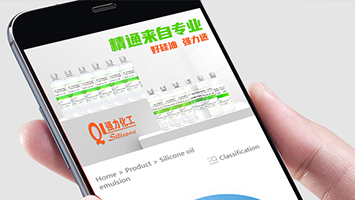Dimethyl silicone oil (polydimethylsiloxane, PDMS) does have certain self-cleaning functions and the ability to reduce ballpoint pen ink adhesion, which is closely related to its unique physical and chemical properties:
1. Mechanism of self-cleaning function
-
Low surface tension and hydrophobicityDimethyl silicone oil has extremely low surface tension (about 20-21 mN/m) and its molecular surface is covered with hydrophobic methyl groups (-CH₃), giving it a natural repellency to water and polar liquids. For example, the protective film formed by silicone oil emulsion on car dashboards can make the water contact angle reach 110°-120°, similar to the hydrophobic effect of lotus leaves, which can effectively prevent water stains and dirt from adhering. This property makes it difficult for pollutants such as dust and oil to stick to the surface, and dirt can be washed away by rain or wiping to achieve self-cleaning.
-
Dynamic film formation and anti-adsorptionSilicone oil molecular chains have high flexibility and fluidity, and can form a dynamic lubricating film on the surface of objects. When the surface is contaminated, the force between pollutant particles and silicone oil molecules is weak, making it easy to be stripped by external forces (such as water flow, air flow). For example, when silicone oil is used as a release agent, it can significantly reduce the accumulation of residues on the mold surface and keep it clean.
-
Chemical stability and durabilityThe Si-O bonds and Si-C bonds of silicone oil are chemically stable and not easily damaged by acids, alkalis, ultraviolet rays, etc., so its hydrophobic and self-cleaning properties can be maintained for a long time. For example, the hydrophobic effect of car glass treated with silicone oil can be maintained for more than several months in an outdoor environment.
2. Repellent effect on ballpoint pen ink
-
Surface energy matchingBallpoint pen ink is usually composed of resin, pigments and solvents, and has a relatively high surface energy (about 30-40 mN/m). In contrast, the low surface energy of dimethyl silicone oil (20-21 mN/m) results in a large interfacial tension with the ink, making it difficult for the ink to spread and adhere to the silicone oil coating surface. For example, silicone-based release films can effectively prevent the adhesion of self-adhesive labels, and similarly, it can be inferred that they have a similar repellent effect on ballpoint pen ink.
-
Lubricity and anti-frictionThe lubricating property of silicone oil can reduce the friction between ink particles and the surface. When the pen tip slides across the silicone oil coating, the ink is more likely to be carried away rather than retained, thereby reducing handwriting residue. For example, when silicone oil is used as the base oil of pen core grease, it can improve writing smoothness and prevent ink from drying and adhering.
-
Practical application casesAlthough there is a lack of direct test data for ballpoint pens, the application of silicone oil in anti-graffiti coatings indirectly proves its potential. For example, anti-graffiti coatings containing silicone oil can easily wipe off oil-based marker pen handwriting through low surface energy and chemical inertness. Under a similar mechanism, silicone oil coatings may also have a certain repellent effect on ballpoint pen ink.
3. Performance limitations and optimization directions
-
Balance between fluidity and durabilityThe fluidity of liquid silicone oil may lead to uneven coating or easy wear, affecting long-term anti-adhesion performance. The mechanical stability and durability of the coating can be enhanced through curing treatment (such as crosslinking to form an elastic film) or compounding with nanomaterials (such as SiO₂).
-
Synergistic effect of surface structureA single silicone oil coating has limited hydrophobicity (contact angle about 100°), while the combination of micro-nano structures (such as pyramid arrays, V-grooves) with silicone oil can further improve self-cleaning ability. For example, the contact angle of PDMS (polydimethylsiloxane) micro-nano textured films can reach 117°, significantly reducing droplet adhesion.
-
Differences in ink typesDifferent formulations of ballpoint pen ink (such as water-based and oil-based) may react differently to silicone oil. For example, oil-based ink may be more likely to adhere than water-based ink due to its higher compatibility with silicone oil, so the coating design needs to be adjusted accordingly.
4. Typical application scenarios
-
Self-cleaning coatings
- Car glass and rearview mirrors: Reduce the adhesion of rainwater and mud, improving driving safety.
- Building exteriors and solar panels: Reduce dust accumulation and improve light transmittance.
- Medical equipment: Inhibit the formation of bacterial biofilms and facilitate cleaning and disinfection.
-
Anti-adhesion and lubrication
- Release films and mold release agents: Prevent adhesion of plastic and rubber products.
- Writing tools: Improve the smoothness of pen cores and reduce ink caking.
- Precision instruments: Reduce friction between mechanical parts and extend service life.
Conclusion
Relying on its low surface tension, hydrophobicity and lubricity, dimethyl silicone oil does have certain self-cleaning functions and ability to reduce ballpoint pen ink adhesion. Its mechanism mainly includes surface repellency, dynamic film formation and chemical stability, and its performance is better when combined with micro-nano structures or curing treatment. Although the actual effect may vary depending on application conditions (such as coating thickness and ink type), existing research and cases have fully proven its potential. In scenarios requiring anti-fouling, easy cleaning or low adhesion, dimethyl silicone oil is an efficient and environmentally friendly choice.




